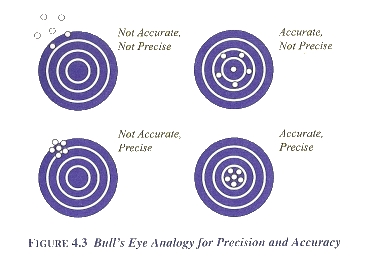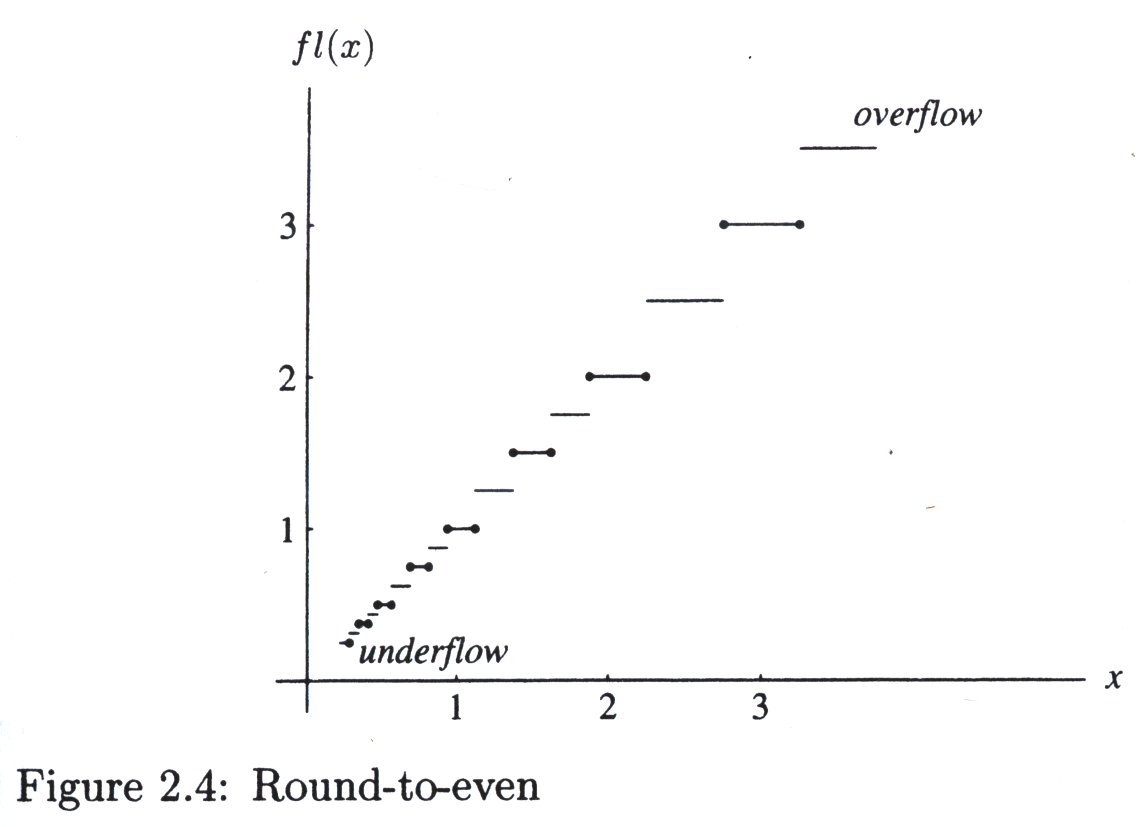- Your second homework set is due, again!:)
- Questions on anything? Current homework? You have an assignment due next Tuesday.
-
Failure to include the denormalized numbers (that don't have a
leading 1) leads to a gap around zero in Figure 2.3, on page 41:
- See if you can make sense of the markings on the graphic above:
, and
- What happens if we restrict a machine so that it has architecture
?
- What happens if we expand the machine so that it has architecture
?
- What if we increase the number of digits (n-digit numbers)?

On the downside, if we allowed non-zero leading digits, then there would be redundant representations for many numbers (e.g. +1.000x10-9=+0.100x10-8)
| Single | Double | |
| Base | 2 | 2 |
| n | 24 | 53 |
| e | [-126:127] | [-1022:1023] |
Question: in each case, how many exponents are there in the exponent range? Of what significance is that number?
Question: let's see if we can make sense of this system with this particular example:

Our authors describe the difference between precision and accuracy at this point: I think that it's best done graphically:

Examples:
"The purpose of rounding in computation is to turn any real number into a machine number, preferably the nearest one." (p. 43)
But there are different ways to do it. You're no doubt familiar with rounding (but how do you handle ties -- that is, how do we round 19.5 to an integer?)). The authors suggest several strategies (p. 43):
- Rule 1: "round-to-even": if the digits following the nth digit are
- less than 500000....
then discard these digits - greater than 500000....
then discard these digits and add 1 to the nth digit - exactly equal to 500000....
then discard these digits and add 1 to the nth digit if it is odd.
"Round-to-even" because if nth digit is even, do nothing; add 1 if odd, making it even. All nth digits become even.

- less than 500000....
- Rule 2: "round-to-nearest, with round away from zero in case of a tie"
Same as Rule 1, except when exactly equal to 500000....
then round UP (away from zero).Inferior to Rule 1, as ever-so-slightly biased away from zero.
- Rule 3: chopping -- "round-to-zero" -- truncation.
Whatever comes after nth, just drop it.
Inferior to Rule 1, as slightly biased toward zero.
The biases are illustrated nicely in Figure 2.5, p. 45 (again, referring to the machine of Fig. 2.3):

The chopping approximations are all under-estimates; the rounding methods give more balanced overs and unders; but the rounding alone has a bias for giving overestimates, which rounding-to-even balances out.
There is some vocabulary here with which we should be familiar: sometimes rounding results in
- overflow (and
)
- underflow (below the smallest possible machine number)
- NaN (not a number)
Definitions:
- fl (float)
- converts real numbers into machine numbers
- A real number is said to be representable if
- it rounds to a machine number (neither overflow nor
underflow, nor NaN).
- relative representation error:
-
The authors make the case that
where
-
is the base, and
-
is the precision (number of decimals in the mantissa)
- #3, p. 48
- #7, p. 49
By "basic operations" the authors mean using standard arithmetic operations on machine numbers to produce machine numbers. There will be errors.
Let a and b be machine numbers, and let represent any of the standard
arithmetic operations. Then
I.e., to compute one of these binary operations with machine numbers,
you do the operation exactly, and then convert it to a machine
number with float (fl). We already know what this will cost:
we'll have a roundoff error of .
As we compute more complicated function, however, with one unary or binary operation after another, the errors continue to accumulate (as seen for example, in section 2.4.5, p. 54).
Examples:
- #1, p. 54: Assuming four digit floating-point arithmetic with
round-to-even rounding, perform the following computations:
(a) 0.6668+0.3334 (b) 1000.-0.05001 (c) 2.000*0.6667 (d) 25.00/16.00 - #8, p. 55
- #9, p. 56
This section features several interesting examples of functions, some of them tremendously important, which are also extraordinarily sensitive to errors.
One of the main points of the section is that a "solution" to a problem may be technically correct, analytically correct, and yet poorly designed to produce good results in general.
An excellent example is the quadratic formula. Many of you have memorized it as
We can imagine situations, however, for which this calculation may be dangerous. What do you notice?
Question: an old trick from your past may be used to improve things: can you think of how to change this formula, to make it less sensitive?